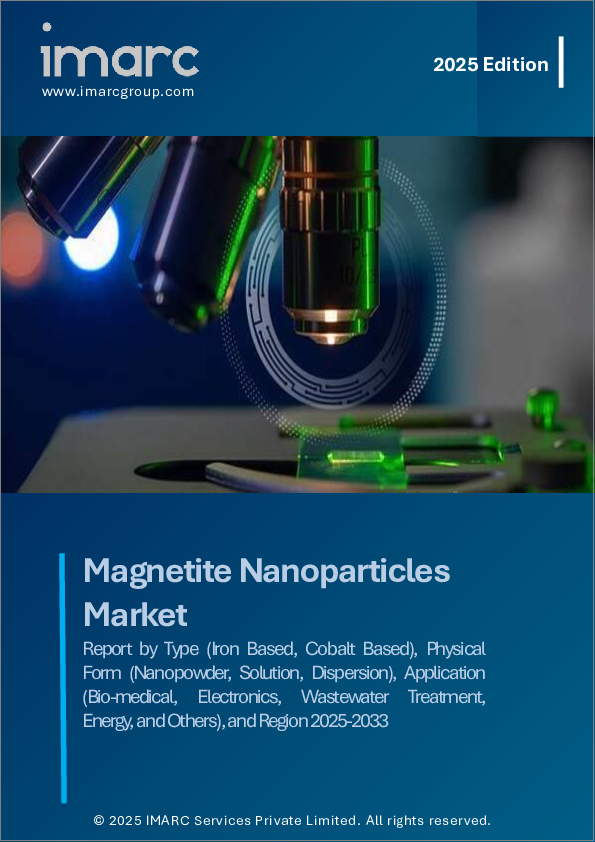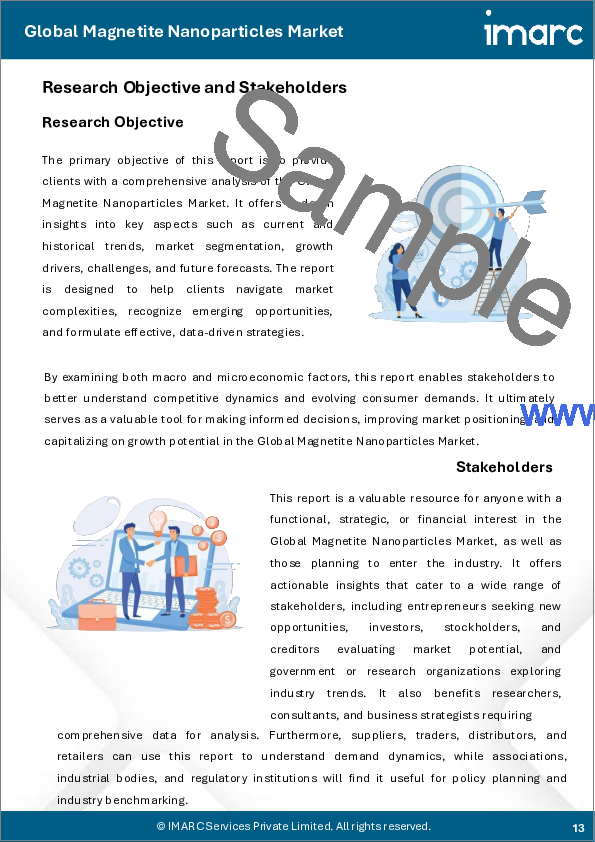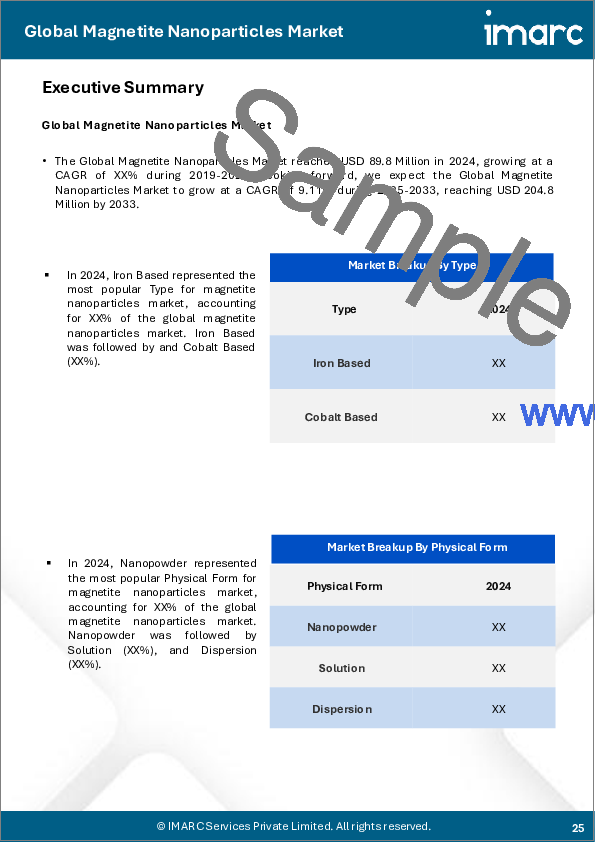|
|
市場調査レポート
商品コード
1702138
マグネタイトナノ粒子市場レポート:タイプ別、物理的形態別、用途別、地域別、2025年~2033年Magnetite Nanoparticles Market Report by Type (Iron Based, Cobalt Based), Physical Form (Nanopowder, Solution, Dispersion), Application (Bio-medical, Electronics, Wastewater Treatment, Energy, and Others), and Region 2025-2033 |
||||||
カスタマイズ可能
|
|||||||
| マグネタイトナノ粒子市場レポート:タイプ別、物理的形態別、用途別、地域別、2025年~2033年 |
|
出版日: 2025年04月01日
発行: IMARC
ページ情報: 英文 145 Pages
納期: 2~3営業日
|
全表示
- 概要
- 図表
- 目次
マグネタイトナノ粒子の世界市場規模は2024年に8,980万米ドルに達しました。今後、IMARC Groupは、市場は2033年までに2億480万米ドルに達し、2025年から2033年の間に9.11%の成長率(CAGR)を示すと予測しています。
マグネタイトナノ粒子(NP)は、鉄、コバルト、ニッケル、白金などの異なる金属元素、または金属合金で構成される構造体であり、常温で超常磁性を示します。そのコンパクトなサイズと無害な特性により、触媒、バイオセンサー、強磁性流体、磁気分離、磁気共鳴イメージング(MRI)造影剤などへの応用が可能です。高い保磁力、低いキュリー温度、優れた磁化率により、マグネタイトNPは現在、新しい生物医学的応用の開発において重要な要素となっています。その結果、世界中でナノ毒性学や磁性ナノテクノロジーの研究開発(R&D)に利用されています。
マグネタイトナノ粒子市場動向:
マグネタイトNPは、がん治療、ドラッグナノキャリア(NC)、標的デリバリーシステム、およびナノプローブや造影剤としての2つの誘導NPを含む診断において広範な用途を見出します。このことは、慢性疾患の有病率の増加、診断方法の改善や個別化治療のニーズの高まりと相まって、市場の成長を後押しする重要な要因の一つとなっています。さらに、磁性NPは、細胞、タンパク質、核酸、酵素、細菌、ウイルスなどの生物学的実体の磁気バイオ分離・検出において牽引力を増しています。これに加えて、マグネタイトNPSの磁気特性は廃水から汚染物質を効率的に除去できるため、凝集、脱乳化、吸着、ろ過、光触媒活性などの廃水処理プロセスに適していると考えられています。さらに、急速に減少する淡水資源と複雑化する廃水が、磁性粒子への需要を押し上げています。これとは別に、研究者は環境汚染を減らすためにグリーンケミストリーによって機能化マグネタイトNPを得ることに注力しています。このような開発は、患者の生活の質を向上させるために、様々な産業用途や医療行為におけるマグネタイトNPの使用を助けると予想されます。
本レポートで扱う主な質問
- 世界のマグネタイトナノ粒子市場の2024年の規模は?
- 世界のマグネタイトナノ粒子市場の2025年から2033年における予想成長率は?
- 世界のマグネタイトナノ粒子市場に対するCOVID-19の影響は?
- 世界のマグネタイトナノ粒子市場を牽引する主要因は何か?
- 世界のマグネタイトナノ粒子市場のタイプ別内訳は?
- 世界のマグネタイトナノ粒子市場の物理的形態別内訳は?
- 世界のマグネタイトナノ粒子市場の用途別内訳は?
- 世界のマグネタイトナノ粒子市場の主要地域は?
- 世界のマグネタイトナノ粒子市場における主要プレイヤー/企業は?
目次
第1章 序文
第2章 調査範囲と調査手法
- 調査の目的
- ステークホルダー
- データソース
- 一次情報
- 二次情報
- 市場推定
- ボトムアップアプローチ
- トップダウンアプローチ
- 調査手法
第3章 エグゼクティブサマリー
第4章 イントロダクション
- 概要
- 主要業界動向
第5章 世界のマグネタイトナノ粒子市場
- 市場概要
- 市場実績
- COVID-19の影響
- 市場予測
第6章 市場内訳:タイプ別
- 鉄ベース
- コバルトベース
第7章 市場内訳:物理的形態別
- ナノパウダー
- ソリューション
- 分散
第8章 市場内訳:用途別
- バイオメディカル
- エレクトロニクス
- 廃水処理
- エネルギー
- その他
第9章 市場内訳:地域別
- 北米
- 米国
- カナダ
- アジア太平洋
- 中国
- 日本
- インド
- 韓国
- オーストラリア
- インドネシア
- その他
- 欧州
- ドイツ
- フランス
- 英国
- イタリア
- スペイン
- ロシア
- その他
- ラテンアメリカ
- ブラジル
- メキシコ
- その他
- 中東・アフリカ
- 市場内訳:国別
第10章 SWOT分析
- 概要
- 強み
- 弱み
- 機会
- 脅威
第11章 バリューチェーン分析
第12章 ポーターのファイブフォース分析
- 概要
- 買い手の交渉力
- 供給企業の交渉力
- 競合の程度
- 新規参入業者の脅威
- 代替品の脅威
第13章 価格分析
第14章 競合情勢
- 市場構造
- 主要企業
- 主要企業のプロファイル
- American Elements
- Cytodiagnostics Inc.
- Merck KGaA
- Nano Research Elements Inc.
- nanoComposix(Fortis Life Sciences)
- Nanografi Nano Technology
- Nanoshel LLC
- Reade International Corp.
- SkySpring Nanomaterials Inc.
- Strem Chemicals Inc.
- US Research Nanomaterials Inc.
List of Figures
- Figure 1: Global: Magnetite Nanoparticles Market: Major Drivers and Challenges
- Figure 2: Global: Magnetite Nanoparticles Market: Sales Value (in Million USD), 2019-2024
- Figure 3: Global: Magnetite Nanoparticles Market Forecast: Sales Value (in Million USD), 2025-2033
- Figure 4: Global: Magnetite Nanoparticles Market: Breakup by Type (in %), 2024
- Figure 5: Global: Magnetite Nanoparticles Market: Breakup by Physical Form (in %), 2024
- Figure 6: Global: Magnetite Nanoparticles Market: Breakup by Application (in %), 2024
- Figure 7: Global: Magnetite Nanoparticles Market: Breakup by Region (in %), 2024
- Figure 8: Global: Magnetite Nanoparticles (Iron Based) Market: Sales Value (in Million USD), 2019 & 2024
- Figure 9: Global: Magnetite Nanoparticles (Iron Based) Market Forecast: Sales Value (in Million USD), 2025-2033
- Figure 10: Global: Magnetite Nanoparticles (Cobalt Based) Market: Sales Value (in Million USD), 2019 & 2024
- Figure 11: Global: Magnetite Nanoparticles (Cobalt Based) Market Forecast: Sales Value (in Million USD), 2025-2033
- Figure 12: Global: Magnetite Nanoparticles (Nanopowder) Market: Sales Value (in Million USD), 2019 & 2024
- Figure 13: Global: Magnetite Nanoparticles (Nanopowder) Market Forecast: Sales Value (in Million USD), 2025-2033
- Figure 14: Global: Magnetite Nanoparticles (Solution) Market: Sales Value (in Million USD), 2019 & 2024
- Figure 15: Global: Magnetite Nanoparticles (Solution) Market Forecast: Sales Value (in Million USD), 2025-2033
- Figure 16: Global: Magnetite Nanoparticles (Dispersion) Market: Sales Value (in Million USD), 2019 & 2024
- Figure 17: Global: Magnetite Nanoparticles (Dispersion) Market Forecast: Sales Value (in Million USD), 2025-2033
- Figure 18: Global: Magnetite Nanoparticles (Bio-medical) Market: Sales Value (in Million USD), 2019 & 2024
- Figure 19: Global: Magnetite Nanoparticles (Bio-medical) Market Forecast: Sales Value (in Million USD), 2025-2033
- Figure 20: Global: Magnetite Nanoparticles (Electronics) Market: Sales Value (in Million USD), 2019 & 2024
- Figure 21: Global: Magnetite Nanoparticles (Electronics) Market Forecast: Sales Value (in Million USD), 2025-2033
- Figure 22: Global: Magnetite Nanoparticles (Wastewater Treatment) Market: Sales Value (in Million USD), 2019 & 2024
- Figure 23: Global: Magnetite Nanoparticles (Wastewater Treatment) Market Forecast: Sales Value (in Million USD), 2025-2033
- Figure 24: Global: Magnetite Nanoparticles (Energy) Market: Sales Value (in Million USD), 2019 & 2024
- Figure 25: Global: Magnetite Nanoparticles (Energy) Market Forecast: Sales Value (in Million USD), 2025-2033
- Figure 26: Global: Magnetite Nanoparticles (Other Applications) Market: Sales Value (in Million USD), 2019 & 2024
- Figure 27: Global: Magnetite Nanoparticles (Other Applications) Market Forecast: Sales Value (in Million USD), 2025-2033
- Figure 28: North America: Magnetite Nanoparticles Market: Sales Value (in Million USD), 2019 & 2024
- Figure 29: North America: Magnetite Nanoparticles Market Forecast: Sales Value (in Million USD), 2025-2033
- Figure 30: United States: Magnetite Nanoparticles Market: Sales Value (in Million USD), 2019 & 2024
- Figure 31: United States: Magnetite Nanoparticles Market Forecast: Sales Value (in Million USD), 2025-2033
- Figure 32: Canada: Magnetite Nanoparticles Market: Sales Value (in Million USD), 2019 & 2024
- Figure 33: Canada: Magnetite Nanoparticles Market Forecast: Sales Value (in Million USD), 2025-2033
- Figure 34: Asia-Pacific: Magnetite Nanoparticles Market: Sales Value (in Million USD), 2019 & 2024
- Figure 35: Asia-Pacific: Magnetite Nanoparticles Market Forecast: Sales Value (in Million USD), 2025-2033
- Figure 36: China: Magnetite Nanoparticles Market: Sales Value (in Million USD), 2019 & 2024
- Figure 37: China: Magnetite Nanoparticles Market Forecast: Sales Value (in Million USD), 2025-2033
- Figure 38: Japan: Magnetite Nanoparticles Market: Sales Value (in Million USD), 2019 & 2024
- Figure 39: Japan: Magnetite Nanoparticles Market Forecast: Sales Value (in Million USD), 2025-2033
- Figure 40: India: Magnetite Nanoparticles Market: Sales Value (in Million USD), 2019 & 2024
- Figure 41: India: Magnetite Nanoparticles Market Forecast: Sales Value (in Million USD), 2025-2033
- Figure 42: South Korea: Magnetite Nanoparticles Market: Sales Value (in Million USD), 2019 & 2024
- Figure 43: South Korea: Magnetite Nanoparticles Market Forecast: Sales Value (in Million USD), 2025-2033
- Figure 44: Australia: Magnetite Nanoparticles Market: Sales Value (in Million USD), 2019 & 2024
- Figure 45: Australia: Magnetite Nanoparticles Market Forecast: Sales Value (in Million USD), 2025-2033
- Figure 46: Indonesia: Magnetite Nanoparticles Market: Sales Value (in Million USD), 2019 & 2024
- Figure 47: Indonesia: Magnetite Nanoparticles Market Forecast: Sales Value (in Million USD), 2025-2033
- Figure 48: Others: Magnetite Nanoparticles Market: Sales Value (in Million USD), 2019 & 2024
- Figure 49: Others: Magnetite Nanoparticles Market Forecast: Sales Value (in Million USD), 2025-2033
- Figure 50: Europe: Magnetite Nanoparticles Market: Sales Value (in Million USD), 2019 & 2024
- Figure 51: Europe: Magnetite Nanoparticles Market Forecast: Sales Value (in Million USD), 2025-2033
- Figure 52: Germany: Magnetite Nanoparticles Market: Sales Value (in Million USD), 2019 & 2024
- Figure 53: Germany: Magnetite Nanoparticles Market Forecast: Sales Value (in Million USD), 2025-2033
- Figure 54: France: Magnetite Nanoparticles Market: Sales Value (in Million USD), 2019 & 2024
- Figure 55: France: Magnetite Nanoparticles Market Forecast: Sales Value (in Million USD), 2025-2033
- Figure 56: United Kingdom: Magnetite Nanoparticles Market: Sales Value (in Million USD), 2019 & 2024
- Figure 57: United Kingdom: Magnetite Nanoparticles Market Forecast: Sales Value (in Million USD), 2025-2033
- Figure 58: Italy: Magnetite Nanoparticles Market: Sales Value (in Million USD), 2019 & 2024
- Figure 59: Italy: Magnetite Nanoparticles Market Forecast: Sales Value (in Million USD), 2025-2033
- Figure 60: Spain: Magnetite Nanoparticles Market: Sales Value (in Million USD), 2019 & 2024
- Figure 61: Spain: Magnetite Nanoparticles Market Forecast: Sales Value (in Million USD), 2025-2033
- Figure 62: Russia: Magnetite Nanoparticles Market: Sales Value (in Million USD), 2019 & 2024
- Figure 63: Russia: Magnetite Nanoparticles Market Forecast: Sales Value (in Million USD), 2025-2033
- Figure 64: Others: Magnetite Nanoparticles Market: Sales Value (in Million USD), 2019 & 2024
- Figure 65: Others: Magnetite Nanoparticles Market Forecast: Sales Value (in Million USD), 2025-2033
- Figure 66: Latin America: Magnetite Nanoparticles Market: Sales Value (in Million USD), 2019 & 2024
- Figure 67: Latin America: Magnetite Nanoparticles Market Forecast: Sales Value (in Million USD), 2025-2033
- Figure 68: Brazil: Magnetite Nanoparticles Market: Sales Value (in Million USD), 2019 & 2024
- Figure 69: Brazil: Magnetite Nanoparticles Market Forecast: Sales Value (in Million USD), 2025-2033
- Figure 70: Mexico: Magnetite Nanoparticles Market: Sales Value (in Million USD), 2019 & 2024
- Figure 71: Mexico: Magnetite Nanoparticles Market Forecast: Sales Value (in Million USD), 2025-2033
- Figure 72: Others: Magnetite Nanoparticles Market: Sales Value (in Million USD), 2019 & 2024
- Figure 73: Others: Magnetite Nanoparticles Market Forecast: Sales Value (in Million USD), 2025-2033
- Figure 74: Middle East and Africa: Magnetite Nanoparticles Market: Sales Value (in Million USD), 2019 & 2024
- Figure 75: Middle East and Africa: Magnetite Nanoparticles Market: Breakup by Country (in %), 2024
- Figure 76: Middle East and Africa: Magnetite Nanoparticles Market Forecast: Sales Value (in Million USD), 2025-2033
- Figure 77: Global: Magnetite Nanoparticles Industry: SWOT Analysis
- Figure 78: Global: Magnetite Nanoparticles Industry: Value Chain Analysis
- Figure 79: Global: Magnetite Nanoparticles Industry: Porter's Five Forces Analysis
List of Tables
- Table 1: Global: Magnetite Nanoparticles Market: Key Industry Highlights, 2024 and 2033
- Table 2: Global: Magnetite Nanoparticles Market Forecast: Breakup by Type (in Million USD), 2025-2033
- Table 3: Global: Magnetite Nanoparticles Market Forecast: Breakup by Physical Form (in Million USD), 2025-2033
- Table 4: Global: Magnetite Nanoparticles Market Forecast: Breakup by Application (in Million USD), 2025-2033
- Table 5: Global: Magnetite Nanoparticles Market Forecast: Breakup by Region (in Million USD), 2025-2033
- Table 6: Global: Magnetite Nanoparticles Market: Competitive Structure
- Table 7: Global: Magnetite Nanoparticles Market: Key Players
The global magnetite nanoparticles market size reached USD 89.8 Million in 2024. Looking forward, IMARC Group expects the market to reach USD 204.8 Million by 2033, exhibiting a growth rate (CAGR) of 9.11% during 2025-2033.
Magnetite nanoparticles (NPs) are structures composed of different metallic elements, such as iron, cobalt, nickel, and platinum, or metal alloys, which exhibit superparamagnetic properties at ambient temperatures. Their compact size and non-toxic properties make them viable for applications in catalysis, biosensors, ferrofluids, magnetic separations, and magnetic resonance imaging (MRI) contrast agents. Due to their high coercivity, low curie temperature, and excellent magnetic susceptibility, magnetite NPs have now become an important element in developing novel biomedical applications. They are consequently used in nanotoxicology and magnetic nanotechnology research and development (R&D) across the globe.
Magnetite Nanoparticles Market Trends:
Magnetite NPs find extensive applications in cancer therapy, drug nanocarriers (NCs), targeted delivery systems, and diagnosis involving two guided NPs as nanoprobes and contrast agents. This, in confluence with the increasing prevalence of chronic diseases and the rising need for improved diagnostic modalities and personalized treatments, represents one of the key factors bolstering the market growth. Moreover, magnetic NPs are gaining traction in magnetic bio-separation and detection of biological entities, such as cells, proteins, nucleic acids, enzymes, bacteria, and viruses. Besides this, as the magnetic properties of magnetite NPS can efficiently remove contaminants from wastewater, they are considered suitable for wastewater treatment processes, including flocculation, demulsification, adsorption, filtration, and photocatalytic activities. In addition, rapidly diminishing freshwater resources and the growing wastewater complexities are driving the demand for magnetic NPs. Apart from this, researchers are focusing on obtaining functionalized magnetite NPs via green chemistry to reduce environmental pollution. Such developments are anticipated to aid the usage of magnetite NPs in various industrial applications and medical practices to improve the quality of life of the patients.
Key Market Segmentation:
Breakup by Type:
- Iron Based
- Cobalt Based
Breakup by Physical Form:
- Nanopowder
- Solution
- Dispersion
Breakup by Application:
- Bio-medical
- Electronics
- Wastewater Treatment
- Energy
- Others
Breakup by Region:
- North America
- United States
- Canada
- Asia-Pacific
- China
- Japan
- India
- South Korea
- Australia
- Indonesia
- Others
- Europe
- Germany
- France
- United Kingdom
- Italy
- Spain
- Russia
- Others
- Latin America
- Brazil
- Mexico
- Others
- Middle East and Africa
Competitive Landscape:
The competitive landscape of the industry has also been examined along with the profiles of the key players being American Elements, Cytodiagnostics Inc., Merck KGaA, Nano Research Elements Inc., nanoComposix (Fortis Life Sciences), Nanografi Nano Technology, Nanoshel LLC, Reade International Corp., SkySpring Nanomaterials Inc., Strem Chemicals Inc. and US Research Nanomaterials Inc.
Key Questions Answered in This Report
- 1.What was the size of the global magnetite nanoparticles market in 2024?
- 2.What is the expected growth rate of the global magnetite nanoparticles market during 2025-2033?
- 3.What has been the impact of COVID-19 on the global magnetite nanoparticles market?
- 4.What are the key factors driving the global magnetite nanoparticles market?
- 5.What is the breakup of the global magnetite nanoparticles market based on the type?
- 6.What is the breakup of the global magnetite nanoparticles market based on the physical form?
- 7.What is the breakup of the global magnetite nanoparticles market based on the application?
- 8.What are the key regions in the global magnetite nanoparticles market?
- 9.Who are the key players/companies in the global magnetite nanoparticles market?
Table of Contents
1 Preface
2 Scope and Methodology
- 2.1 Objectives of the Study
- 2.2 Stakeholders
- 2.3 Data Sources
- 2.3.1 Primary Sources
- 2.3.2 Secondary Sources
- 2.4 Market Estimation
- 2.4.1 Bottom-Up Approach
- 2.4.2 Top-Down Approach
- 2.5 Forecasting Methodology
3 Executive Summary
4 Introduction
- 4.1 Overview
- 4.2 Key Industry Trends
5 Global Magnetite Nanoparticles Market
- 5.1 Market Overview
- 5.2 Market Performance
- 5.3 Impact of COVID-19
- 5.4 Market Forecast
6 Market Breakup by Type
- 6.1 Iron Based
- 6.1.1 Market Trends
- 6.1.2 Market Forecast
- 6.2 Cobalt Based
- 6.2.1 Market Trends
- 6.2.2 Market Forecast
7 Market Breakup by Physical Form
- 7.1 Nanopowder
- 7.1.1 Market Trends
- 7.1.2 Market Forecast
- 7.2 Solution
- 7.2.1 Market Trends
- 7.2.2 Market Forecast
- 7.3 Dispersion
- 7.3.1 Market Trends
- 7.3.2 Market Forecast
8 Market Breakup by Application
- 8.1 Bio-medical
- 8.1.1 Market Trends
- 8.1.2 Market Forecast
- 8.2 Electronics
- 8.2.1 Market Trends
- 8.2.2 Market Forecast
- 8.3 Wastewater Treatment
- 8.3.1 Market Trends
- 8.3.2 Market Forecast
- 8.4 Energy
- 8.4.1 Market Trends
- 8.4.2 Market Forecast
- 8.5 Others
- 8.5.1 Market Trends
- 8.5.2 Market Forecast
9 Market Breakup by Region
- 9.1 North America
- 9.1.1 United States
- 9.1.1.1 Market Trends
- 9.1.1.2 Market Forecast
- 9.1.2 Canada
- 9.1.2.1 Market Trends
- 9.1.2.2 Market Forecast
- 9.1.1 United States
- 9.2 Asia-Pacific
- 9.2.1 China
- 9.2.1.1 Market Trends
- 9.2.1.2 Market Forecast
- 9.2.2 Japan
- 9.2.2.1 Market Trends
- 9.2.2.2 Market Forecast
- 9.2.3 India
- 9.2.3.1 Market Trends
- 9.2.3.2 Market Forecast
- 9.2.4 South Korea
- 9.2.4.1 Market Trends
- 9.2.4.2 Market Forecast
- 9.2.5 Australia
- 9.2.5.1 Market Trends
- 9.2.5.2 Market Forecast
- 9.2.6 Indonesia
- 9.2.6.1 Market Trends
- 9.2.6.2 Market Forecast
- 9.2.7 Others
- 9.2.7.1 Market Trends
- 9.2.7.2 Market Forecast
- 9.2.1 China
- 9.3 Europe
- 9.3.1 Germany
- 9.3.1.1 Market Trends
- 9.3.1.2 Market Forecast
- 9.3.2 France
- 9.3.2.1 Market Trends
- 9.3.2.2 Market Forecast
- 9.3.3 United Kingdom
- 9.3.3.1 Market Trends
- 9.3.3.2 Market Forecast
- 9.3.4 Italy
- 9.3.4.1 Market Trends
- 9.3.4.2 Market Forecast
- 9.3.5 Spain
- 9.3.5.1 Market Trends
- 9.3.5.2 Market Forecast
- 9.3.6 Russia
- 9.3.6.1 Market Trends
- 9.3.6.2 Market Forecast
- 9.3.7 Others
- 9.3.7.1 Market Trends
- 9.3.7.2 Market Forecast
- 9.3.1 Germany
- 9.4 Latin America
- 9.4.1 Brazil
- 9.4.1.1 Market Trends
- 9.4.1.2 Market Forecast
- 9.4.2 Mexico
- 9.4.2.1 Market Trends
- 9.4.2.2 Market Forecast
- 9.4.3 Others
- 9.4.3.1 Market Trends
- 9.4.3.2 Market Forecast
- 9.4.1 Brazil
- 9.5 Middle East and Africa
- 9.5.1 Market Trends
- 9.5.2 Market Breakup by Country
- 9.5.3 Market Forecast
10 SWOT Analysis
- 10.1 Overview
- 10.2 Strengths
- 10.3 Weaknesses
- 10.4 Opportunities
- 10.5 Threats
11 Value Chain Analysis
12 Porters Five Forces Analysis
- 12.1 Overview
- 12.2 Bargaining Power of Buyers
- 12.3 Bargaining Power of Suppliers
- 12.4 Degree of Competition
- 12.5 Threat of New Entrants
- 12.6 Threat of Substitutes
13 Price Analysis
14 Competitive Landscape
- 14.1 Market Structure
- 14.2 Key Players
- 14.3 Profiles of Key Players
- 14.3.1 American Elements
- 14.3.1.1 Company Overview
- 14.3.1.2 Product Portfolio
- 14.3.2 Cytodiagnostics Inc.
- 14.3.2.1 Company Overview
- 14.3.2.2 Product Portfolio
- 14.3.3 Merck KGaA
- 14.3.3.1 Company Overview
- 14.3.3.2 Product Portfolio
- 14.3.3.3 Financials
- 14.3.3.4 SWOT Analysis
- 14.3.4 Nano Research Elements Inc.
- 14.3.4.1 Company Overview
- 14.3.4.2 Product Portfolio
- 14.3.5 nanoComposix (Fortis Life Sciences)
- 14.3.5.1 Company Overview
- 14.3.5.2 Product Portfolio
- 14.3.6 Nanografi Nano Technology
- 14.3.6.1 Company Overview
- 14.3.6.2 Product Portfolio
- 14.3.7 Nanoshel LLC
- 14.3.7.1 Company Overview
- 14.3.7.2 Product Portfolio
- 14.3.8 Reade International Corp.
- 14.3.8.1 Company Overview
- 14.3.8.2 Product Portfolio
- 14.3.9 SkySpring Nanomaterials Inc.
- 14.3.9.1 Company Overview
- 14.3.9.2 Product Portfolio
- 14.3.10 Strem Chemicals Inc.
- 14.3.10.1 Company Overview
- 14.3.10.2 Product Portfolio
- 14.3.11 US Research Nanomaterials Inc.
- 14.3.11.1 Company Overview
- 14.3.11.2 Product Portfolio
- 14.3.1 American Elements





